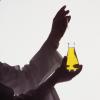剛發現剛出版的英文專著Gas Biology Research in Clinical Practice,主編是兩個日本京都的學者:
Yoshikawa, T. (Kyoto); Naito, Y. (Kyoto)。(很奇怪的是,關于氫氣的章節,為什么沒有就近請在東京日本醫科大學的太田教授執筆,反而跑美國找Nakao教授來寫,無論在學術水平和氫氣本身的研究基礎,前者都更合適,可能是考慮英語水平的問題。)
該著作中有關于氫氣的內容。其中的第四篇是氫氣的醫學應用。作者是美國匹茲堡大學的Atsunori
Nakao,他寫了本書的其中二篇,在第四篇全面介紹了氫氣的研究進展。過去雖然有幾本關于氫氣生物學效應的書,但都是為宣傳產品而寫的商業味道很濃,雖然有一定科普價值,但都非常不嚴肅,學術價值非常小。現在這本專著是歷史上首次把氫氣的醫學應用編寫進來,具有十分重要的意義。
第四篇的題目是氫氣和醫學應用(Hydrogen and
Medical Application)。
中文摘要:大量基礎和臨床研究表明,氫氣是一種重要的生理調節因子,在細胞和器官水平上,具有抗氧化、抗炎癥和抗細胞凋亡的作用,對許多疾病具有治療效果。最近,氫氣被確定為氣體信號分子(吹牛),類似一氧化氮和一氧化碳。利用氫氣治療疾病的給氫方式包括直接呼吸、飲氫氣水或注射含氫氣的溶液。本文將針對氫氣治療疾病的有關進展進行系統總結。氫氣將對人類治療疾病中發揮重大影響。這個內容好像與他們上次發表在Free Rad Res 上的綜述基本一樣。
Hydrogen and Medical
Application
Atsunori Nakao Department of Surgery, University of Pittsburgh Medical
Center, Pittsburgh, Pa., USA
A number of basic and clinical researches have revealed
that hydrogen is an important physiological regulatory factor with antioxidant,
anti- inflammatory and anti- apoptotic protective effects on cells and organs,
with properties to mitigate various disease status. Recently, hydrogen gas has
been identified as a signaling gas molecule like nitric oxide and carbon
monoxide. Therapeutic hydrogen has been applied by different delivery methods
including straightforward inhalation, drinking hydrogen dissolved in water and
injection with hydrogen- saturated saline. Herein, I summarize currently
available data regarding the protective role of hydrogen in medicine, provide an
outline of recent advances in research on the use of hydrogen as a therapeutic
medical gas in diverse
models of disease, and discuss the feasibility of hydrogen as a therapeutic
strategy. Hydrogen’s impact on therapeutic and preventive medicine could be
enormous in the future.
In 2007, it was demonstrated that molecular hydrogen
selectively reduces the levels of
hydroxyl radicals and peroxynitrite in vitro and also
exerts potent antioxidant activity
in an in vivo rat cerebral ischemia model [1]. Since
then, there has been accumulating
evidence that hydrogen can act as a selective scavenger
of hydroxyl radicals, and have
potent anti- inflammatory and antiapoptotic properties
[2].
Hydrogen is one very promising gaseous agent that has
come to the forefront
of research during the last few years. Previous studies
have shown that nitric oxide
(NO),
carbon monoxide (CO) and hydrogen sulfide (H2S)
have cytoprotective
effects in multiple experimental/clinical disease models
and recognized as ‘signaling
gas molecules’ for regulation of physiological functions.
Given the recent increasing
number of systems in which hydrogen is shown to mediate
beneficial effects, the functions of hydrogen are likely due, in part, to the
reactive oxygen species (ROS)-
scavenging properties of hydrogen. However, the
scavenging properties of hydrogen an overview on the role of various gaseous molecules in
health and disease The substantial biological importance of gaseous
mediators in various physiological-pathological conditions has been realized
only recently, but to date, the detailed mechanisms involved remain elusive. The
publication at hand contains 16 overviews written by a panel of experts who
summarize the current knowledge and provide fundamental insights into the roles
of gaseous molecules in signal transduction in biological systems. The first
part provides a comprehensive overview on gaseous mediators in health and
disease. In the second part, the medical application of various molecules such
as nitric oxide, carbon monoxide, hydrogen sulfide, hydrogen, acetone and
phytoncide are discussed. Furthermore, articles on skin gas biology and
Carbon-13 (13C), especially clinical applications of 13C-labeled substrate are
included. This book
provides valuable information not only for basic researchers in physiology and
biochemistry, but also for gastroenterologists and clinicians who wish to learn
more about the role of gaseous mediators.
另外Atsunori Nakao本書中也寫了一章關于醫用治療氣體的內容(Therapeutic Medical
Gas,沒有考慮好怎么翻譯。覺得“醫用治療氣體”別扭)。
Therapeutic Medical Gas
Therapeutic medical gas is
pharmaceutical gaseous molecules which offer solutions to medical needs. In
addition to traditional medical gases including oxygen and nitrous oxide, a
number of medical gases have been recently discovered to play protective roles
in various disease conditions. In particular, nitric oxide, carbon monoxide and
hydrogen sulfide are found to be endogenously generated in the human body and
mediate signaling pathways as biological messengers, and are shown to have
potent cytoprotective effects. Herein, we summarize the recent advances of
therapeutic medical gas research and discuss their clinical feasibility,
typically such as nitric oxide, carbon monoxide, hydrogen sulfide, hydrogen,
xenon, helium and ozone. A recent increase in publications in the medical gas
field clearly indicates that there are significant opportunities for the use of
medical gases as therapeutic tools. It would be necessary to identify safety
concerns when using therapeutic gases along with potential side effects and
toxicity. Although further investigations are required, medical gas may provide
a huge impact as a novel and innovative therapeutic tool for unmet medical needs with
considerable health burdens.
What Is ‘Therapeutic Medical
Gas’?
The definition of ‘therapeutic medical
gas’ is the pharmaceutical gaseous molecules which are applied to the human body
for the purpose of a variety of medical conditions and producing other desirable
effects. It is no doubt that oxygen therapy to increase tissue oxygenation has been a
mainstream in critical care medicine. However, recent observations in
experimental and clinical studies clearly revealed the needs to provide
additional supplemental gases to patients with many etiologies. The list of
therapeutic medical gases has been growing continuously (table 1). Herein, we
discuss the recent advances in medical gas research and delivery mechanisms
including clinical application for special gases with recently discovered roles
as protective properties.


